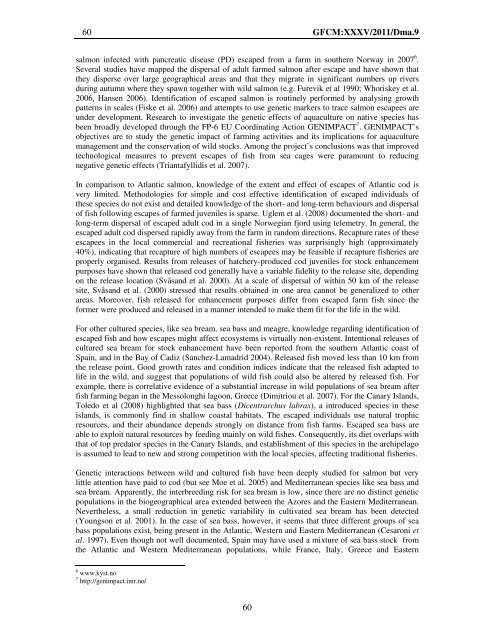Site selection and carrying capacity in Mediterranean ... - FAO Sipam
Site selection and carrying capacity in Mediterranean ... - FAO Sipam
Site selection and carrying capacity in Mediterranean ... - FAO Sipam
Create successful ePaper yourself
Turn your PDF publications into a flip-book with our unique Google optimized e-Paper software.
60 GFCM:XXXV/2011/Dma.9<br />
salmon <strong>in</strong>fected with pancreatic disease (PD) escaped from a farm <strong>in</strong> southern Norway <strong>in</strong> 2007 6 .<br />
Several studies have mapped the dispersal of adult farmed salmon after escape <strong>and</strong> have shown that<br />
they disperse over large geographical areas <strong>and</strong> that they migrate <strong>in</strong> significant numbers up rivers<br />
dur<strong>in</strong>g autumn where they spawn together with wild salmon (e.g. Furevik et al 1990; Whoriskey et al.<br />
2006, Hansen 2006). Identification of escaped salmon is rout<strong>in</strong>ely performed by analys<strong>in</strong>g growth<br />
patterns <strong>in</strong> scales (Fiske et al. 2006) <strong>and</strong> attempts to use genetic markers to trace salmon escapees are<br />
under development. Research to <strong>in</strong>vestigate the genetic effects of aquaculture on native species has<br />
been broadly developed through the FP-6 EU Coord<strong>in</strong>at<strong>in</strong>g Action GENIMPACT 7 . GENIMPACT’s<br />
objectives are to study the genetic impact of farm<strong>in</strong>g activities <strong>and</strong> its implications for aquaculture<br />
management <strong>and</strong> the conservation of wild stocks. Among the project’s conclusions was that improved<br />
technological measures to prevent escapes of fish from sea cages were paramount to reduc<strong>in</strong>g<br />
negative genetic effects (Triantafyllidis et al. 2007).<br />
In comparison to Atlantic salmon, knowledge of the extent <strong>and</strong> effect of escapes of Atlantic cod is<br />
very limited. Methodologies for simple <strong>and</strong> cost effective identification of escaped <strong>in</strong>dividuals of<br />
these species do not exist <strong>and</strong> detailed knowledge of the short- <strong>and</strong> long-term behaviours <strong>and</strong> dispersal<br />
of fish follow<strong>in</strong>g escapes of farmed juveniles is sparse. Uglem et al. (2008) documented the short- <strong>and</strong><br />
long-term dispersal of escaped adult cod <strong>in</strong> a s<strong>in</strong>gle Norwegian fjord us<strong>in</strong>g telemetry. In general, the<br />
escaped adult cod dispersed rapidly away from the farm <strong>in</strong> r<strong>and</strong>om directions. Recapture rates of these<br />
escapees <strong>in</strong> the local commercial <strong>and</strong> recreational fisheries was surpris<strong>in</strong>gly high (approximately<br />
40%), <strong>in</strong>dicat<strong>in</strong>g that recapture of high numbers of escapees may be feasible if recapture fisheries are<br />
properly organised. Results from releases of hatchery-produced cod juveniles for stock enhancement<br />
purposes have shown that released cod generally have a variable fidelity to the release site, depend<strong>in</strong>g<br />
on the release location (Svås<strong>and</strong> et al. 2000). At a scale of dispersal of with<strong>in</strong> 50 km of the release<br />
site, Svås<strong>and</strong> et al. (2000) stressed that results obta<strong>in</strong>ed <strong>in</strong> one area cannot be generalized to other<br />
areas. Moreover, fish released for enhancement purposes differ from escaped farm fish s<strong>in</strong>ce the<br />
former were produced <strong>and</strong> released <strong>in</strong> a manner <strong>in</strong>tended to make them fit for the life <strong>in</strong> the wild.<br />
For other cultured species, like sea bream, sea bass <strong>and</strong> meagre, knowledge regard<strong>in</strong>g identification of<br />
escaped fish <strong>and</strong> how escapes might affect ecosystems is virtually non-existent. Intentional releases of<br />
cultured sea bream for stock enhancement have been reported from the southern Atlantic coast of<br />
Spa<strong>in</strong>, <strong>and</strong> <strong>in</strong> the Bay of Cadiz (Sanchez-Lamadrid 2004). Released fish moved less than 10 km from<br />
the release po<strong>in</strong>t. Good growth rates <strong>and</strong> condition <strong>in</strong>dices <strong>in</strong>dicate that the released fish adapted to<br />
life <strong>in</strong> the wild, <strong>and</strong> suggest that populations of wild fish could also be altered by released fish. For<br />
example, there is correlative evidence of a substantial <strong>in</strong>crease <strong>in</strong> wild populations of sea bream after<br />
fish farm<strong>in</strong>g began <strong>in</strong> the Messolonghi lagoon, Greece (Dimitriou et al. 2007). For the Canary Isl<strong>and</strong>s,<br />
Toledo et al (2008) highlighted that sea bass (Dicentrarchus labrax), a <strong>in</strong>troduced species <strong>in</strong> these<br />
isl<strong>and</strong>s, is commonly f<strong>in</strong>d <strong>in</strong> shallow coastal habitats. The escaped <strong>in</strong>dividuals use natural trophic<br />
resources, <strong>and</strong> their abundance depends strongly on distance from fish farms. Escaped sea bass are<br />
able to exploit natural resources by feed<strong>in</strong>g ma<strong>in</strong>ly on wild fishes. Consequently, its diet overlaps with<br />
that of top predator species <strong>in</strong> the Canary Isl<strong>and</strong>s, <strong>and</strong> establishment of this species <strong>in</strong> the archipelago<br />
is assumed to lead to new <strong>and</strong> strong competition with the local species, affect<strong>in</strong>g traditional fisheries.<br />
Genetic <strong>in</strong>teractions between wild <strong>and</strong> cultured fish have been deeply studied for salmon but very<br />
little attention have paid to cod (but see Moe et al. 2005) <strong>and</strong> <strong>Mediterranean</strong> species like sea bass <strong>and</strong><br />
sea bream. Apparently, the <strong>in</strong>terbreed<strong>in</strong>g risk for sea bream is low, s<strong>in</strong>ce there are no dist<strong>in</strong>ct genetic<br />
populations <strong>in</strong> the biogeographical area extended between the Azores <strong>and</strong> the Eastern <strong>Mediterranean</strong>.<br />
Nevertheless, a small reduction <strong>in</strong> genetic variability <strong>in</strong> cultivated sea bream has been detected<br />
(Youngson et al. 2001). In the case of sea bass, however, it seems that three different groups of sea<br />
bass populations exist, be<strong>in</strong>g present <strong>in</strong> the Atlantic, Western <strong>and</strong> Eastern <strong>Mediterranean</strong> (Cesaroni et<br />
al. 1997). Even though not well documented, Spa<strong>in</strong> may have used a mixture of sea bass stock from<br />
the Atlantic <strong>and</strong> Western <strong>Mediterranean</strong> populations, while France, Italy, Greece <strong>and</strong> Eastern<br />
6 www.kyst.no<br />
7 http://genimpact.imr.no/<br />
60
















